
Berfu Ulusoy
Berfu is an Employee Experience Specialist at Zavvy. She has a background in learning psychology and helps our customers get the most out of their people enablement programs.

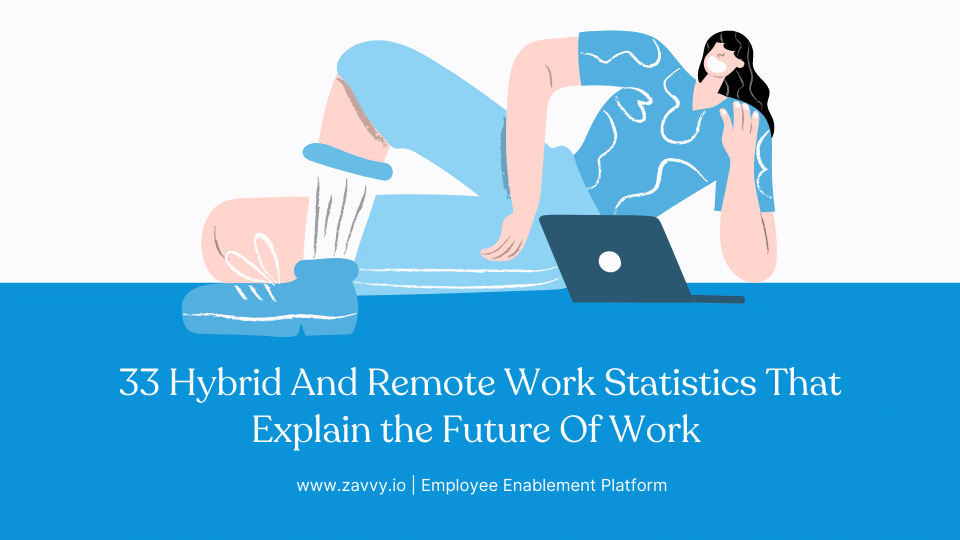
"Everyone at Tesla is required to spend a minimum of 40 hours in the office per week," Elon Musk wrote to his staff. "If you don't show up, we will assume you have resigned." He also added that if this policy is not acceptable to employees, they can "pretend to work somewhere else."
Tesla is not the only company opposing remote or hybrid work models. About 50% of leaders say their company already requires or is planning to require employees to return to in-person work full-time in the next year.
This is in stark contrast to the employee perspective. For example, 97% of employees from a Buffer study said they would recommend remote work to others. And 97% said they would like to work remotely for the rest of their careers at least some of the time.
Remote work and the Great Resignation didn't make sense until we heard most quitters cited one common reason, "our employer doesn't offer flexibility." So, there is a clear disconnect between employers and employees.
This is why it is essential to look at hybrid and remote work statistics and adjust your work mode policies. We have collected the most relevant data that describe the state and dynamics of remote and hybrid work in 2022.
Spoiler alert: you will find 30+ hybrid and remote work statistics that show how the future of work will not be office-centric.
Together with our curators, we have created a library of actionable digital marketing resources. Personalized to your team's needs.
97% out of 2,118 working people from 16 countries would like to work remotely, at least some of the time, for the rest of their careers. What does that tell you?
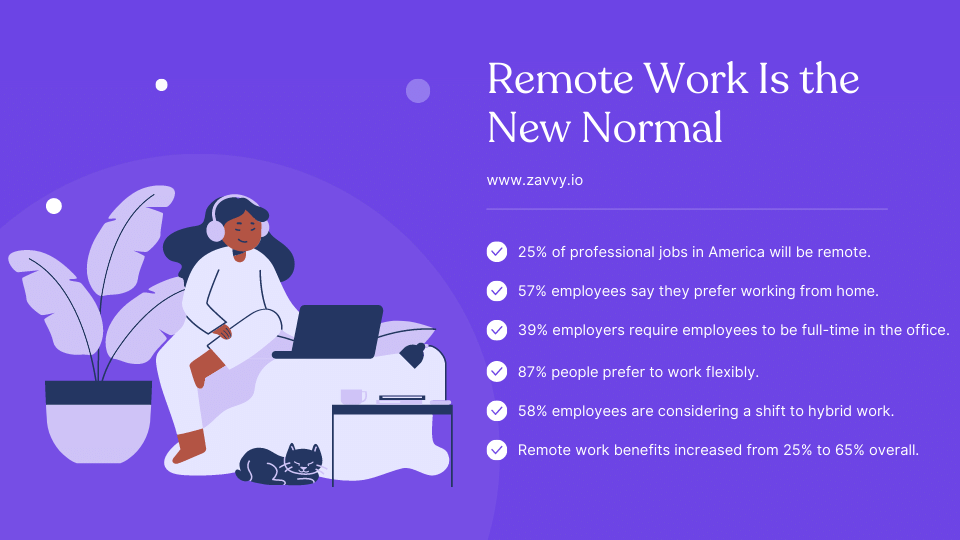
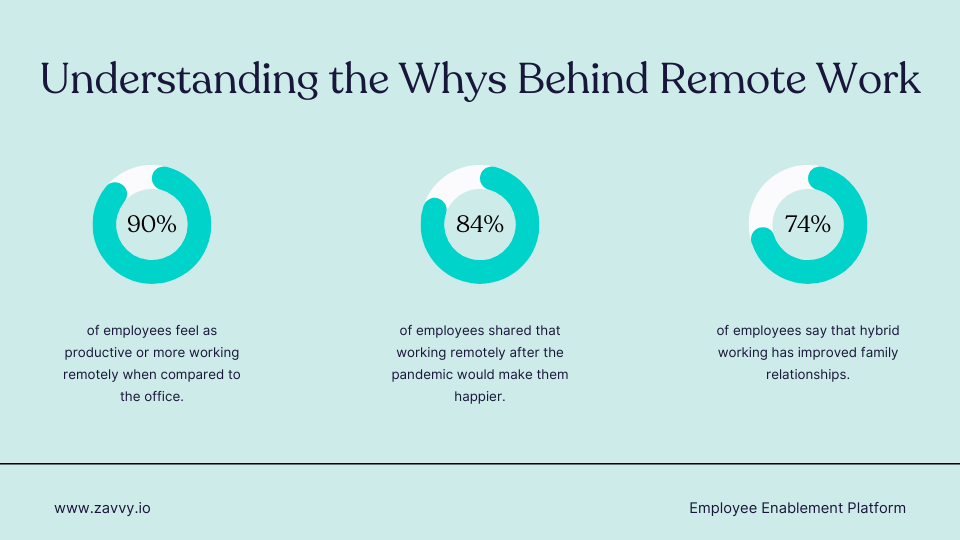
Since the pandemic started, most people have enjoyed and realized the potential benefits of working remotely. They value work-life balance, and maybe it's time for all employers to have a shared realization:
Most workers feel they are at the same productivity level — or higher — working from home compared to the office. Understanding why remote or hybrid work has positively impacted employee productivity could benefit organizations and HR.
These remote work statistics imply flexibility makes people happier. It's human nature to put in more effort when we are most comfortable and happy. And asking people to return to the office even when employee performance has increased shows a lack of trust.
Simply put, employees need a reason to return to offices, even those working in a hybrid work environment. It makes more sense when they have relished the moments of staying more with the family in challenging times such as Covid-19.
That's why even employees without children under 18 are nearly three times as likely to prefer on-site work. However, the majority still prefer more flexible models.
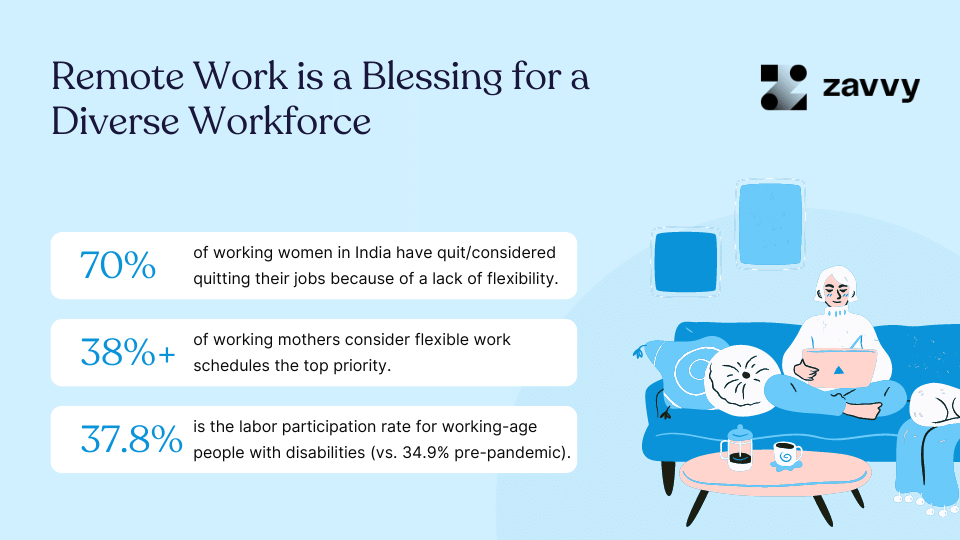
Let's face the sad reality: people expect women to take care of household chores, directly impacting their continuous workforce participation.
However, with flexible work options, companies have seen how they can add wings to their diversity programs and even welcome women who went on long career breaks post maternity.
We saw how Black Lives Matter reignited the debate of ensuring safety and a better life for ethnic groups, including the corporate world. When diverse groups work from home, it results in a positive experience.
That's why 38% of Black male employees and 33% of Black female employees would prefer a fully flexible schedule, compared to 25% of white female employees and 26% of white male employees. (Future Forum)
"Post pandemic, when remote working became the norm, the participation rate for working-age people with disabilities is now at 37.8%. This means that people with disabilities are engaging with the labor force in higher numbers than before the pandemic," stresses Philip Kahn-Pauli, the policy and practices director at disability advocacy nonprofit RespectAbility.
A flexible working environment provides multifaceted advantages to people and organizations. You need to have one thing: the mindset.
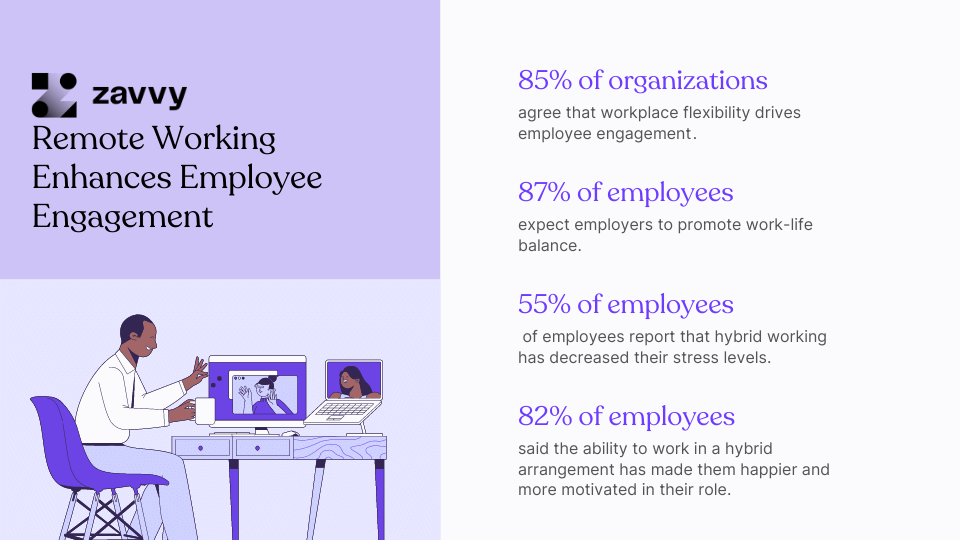
Employee engagement remains the most significant responsibility of HR and the company's leadership with or without a pandemic.
However, it seems remote working came with a blessing in disguise. What arrived as a significant disruptor became a model enabling employees to control their working time and place. This also brought the question of trust to the core. Do employers trust employees to be doing their work from home?
As American educator and author Stephen Covey put it, "Trust is the highest form of human motivation. It brings out the very best in people."
➡️ Check out 46 employee engagement statistics HR managers should know in 2022.
When the market says more than 85 million jobs could go unfilled by 2030 because there aren't enough skilled people to take them, it's wise to consider the benefits of cross-border recruitment and remote work.
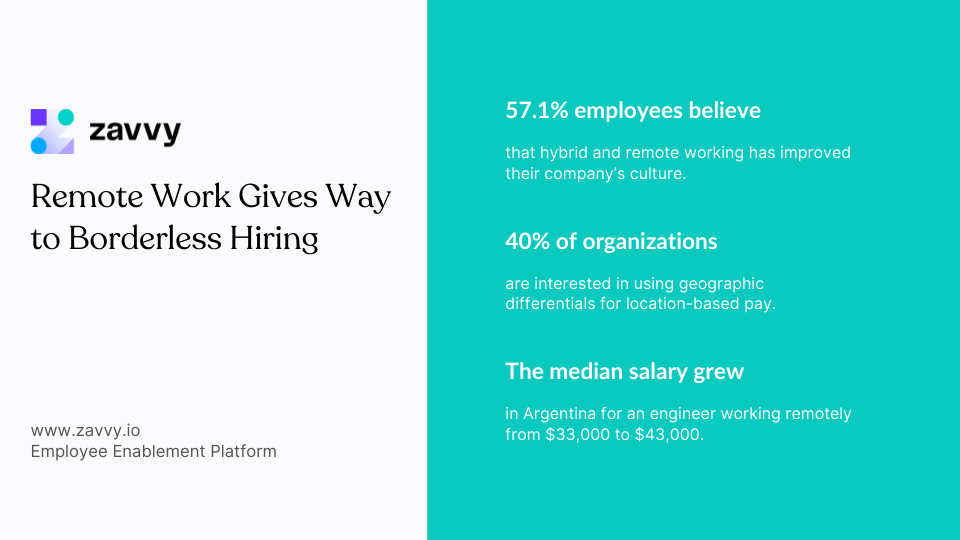
The prominence of borderless hiring also contributes to raising wages in various parts of the world.
And it makes plain sense why Indian workers, especially techies, are always in demand in the West — available in huge numbers and ready to work for less pay than local talent.
The pandemic disrupted it even more. The increase in demand has directly positively impacted their median pay too. It's like a cherry on the top of a sundae.
This is what the employees think and demand. It's not just a case of just one company. Though silent, these 54% people are those, who make up a large chunk of the population behind "The Great Reshuffle." These are the people creating the new definition of the new normal.
Before the pandemic, most CHRO discussions focused on attracting top talent by offering competitive salaries and additional benefits. Now, remote and hybrid work options are key discussion points for recruiting talent and even a core component of employer branding.
➡️ Need inspiration for your employee retention strategy? Check out 8 expert tips from L&D Professionals.
Not providing employee flexibility might send them the message that you simply do not care about their health concerns.
About a quarter of workers who are not working exclusively from home and who have at least some in-person interactions at work (26%) say they are more concerned about being exposed to the coronavirus at work than they were before the omicron variant started to spread in the US in December 2021. (Pew Research)
Plus, calling employees back to the office and enforcing vaccine mandates pose another challenge. When Boeing announced the plan to require its 125,000 US workers to be vaccinated, around 200 employees staged protests shouting: coercion is not consent.
Beware: Even your most loyal employees could join your competitors if you fail to address their queries about your rigidness in calling them to the office.
This happened at Google when several employees said they might resign if not offered flexibility over remote working.
It's just a matter of time before it catches another corporate behemoth engulfing small and medium businesses too.
Well, it's not that remote work is a new dish introduced during pandemic-led lockdowns. It has always been there. All that we needed was to gain a little perspective. Unsurprisingly, various business forums are filled with intros that regard Covid as a "blessing in disguise."
Nevertheless, every coin has two sides. Despite offering unlimited leaves, burnout is real. Companies need to realize flexibility will always be there, and it's for them to put enabling policies in place, keeping their HR at the forefront of leading this change.
Remote and hybrid work is here to stay, and the sooner you get proactive about it, the better it will be for your talent strategies. Ensure that remote new hires get a flying start at their new jobs with Zavvy's employee onboarding software.
But don't forget about current employees either. With Zavvy's connection programs, none of your employees will feel isolated. Stay in sync with employee satisfaction and wellbeing by using our feedback feature and be reactive by addressing the results.
As per statistics, 90% of employees feel as productive or more working remotely when compared to the office. Remote work saves a lot of time from commuting and relieves employees from the stress of going to the office, which directly adds up their productive time.
Compensation remains the most crucial factor for employees choosing their workplaces. But interestingly, research suggests employees are willing to take a pay cut if their employer offers remote work even after the pandemic ends.
In the future, remote working has an optimistic chance of becoming a norm, at least for the service sector. For others, hybrid work culture will make way for the new meaning of flexibility, as 54% of employees working exclusively from home said they would likely look for another job if their employer stopped offering remote-work options.
Remote workers do not receive lower salaries. From July to December 2021, the wages of people hired through an outsourcing company grew in Mexico (by 57%), Canada (38%), Pakistan (27%), Argentina (21%), and India (8%). Remote working has increased the opportunity for outsourced talent, disrupting the age-old gap between low supply and huge demand.
Remote working comes with many plus points, including flexibility, saving commute time and money, increasing opportunity for working mothers, offering borderless talent movement, etc. However, on the flip side, it comes up with some risks (if not being checked) of burnout and blurring the line between personal and professional life (Pew Research).
Upskill your team every week with the best contents and personalized recommendations.

"Everyone at Tesla is required to spend a minimum of 40 hours in the office per week," Elon Musk wrote to his staff. "If you don't show up, we will assume you have resigned." He also added that if this policy is not acceptable to employees, they can "pretend to work somewhere else."
Tesla is not the only company opposing remote or hybrid work models. About 50% of leaders say their company already requires or is planning to require employees to return to in-person work full-time in the next year.
This is in stark contrast to the employee perspective. For example, 97% of employees from a Buffer study said they would recommend remote work to others. And 97% said they would like to work remotely for the rest of their careers at least some of the time.
Remote work and the Great Resignation didn't make sense until we heard most quitters cited one common reason, "our employer doesn't offer flexibility." So, there is a clear disconnect between employers and employees.
This is why it is essential to look at hybrid and remote work statistics and adjust your work mode policies. We have collected the most relevant data that describe the state and dynamics of remote and hybrid work in 2022.
Spoiler alert: you will find 30+ hybrid and remote work statistics that show how the future of work will not be office-centric.
Get a demo!
We'll be happy to show you around and answer all your questions.
Trusted by innovative companies



We'll be happy to show you around, answer your questions, or arrange a free trial.
Erhalten Sie eine kostenlose Demo unserer Onboarding-Software.
Vertraut von



Your Training & Development Strategy - Solved in 1 Tool.
Trusted by innovative companies



We'll be happy to show you around, answer your questions, or arrange a free trial.
Learn how Zavvy helps you drive performance, development, and engagement.
Trusted by innovative companies



We'll be happy to show you around, answer your questions, or arrange a free trial.
We'll be happy to show you around and answer all your questions.
Trusted by innovative companies



We'll be happy to show you around, answer your questions, or arrange a free trial.
Gerne zeigen wir Ihnen ganz unverbindlich unsere Plattform im Detail.
Vertraut von modernen Unternehmen



Get a demo!
We'll be happy to show you around and answer all your questions.
Trusted by innovative companies



We'll be happy to show you around, answer your questions, or arrange a free trial.
Erhalten Sie eine kostenlose Demo unserer Software für Mitarbeiterenwicklung und Training.
Moderne Unternehmen
setzen auf Zavvy


